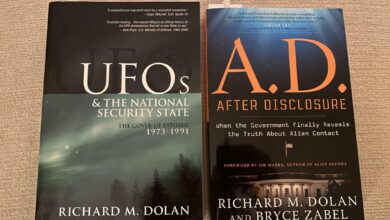Unlocking the Mystery: Donald Keyhoe’s Groundbreaking Insights in ‘The Flying Saucers Are Real’

Exploring the Impact of Major Donald Keyhoe on Ufology: A Response to Richard Dolan’s Review of “Imminent”
In the world of ufology, few names resonate as deeply as that of Major Donald E. Keyhoe. His pivotal work in the field has recently come under the spotlight thanks to Richard Dolan’s video review of Luis Elizondo’s upcoming book, “Imminent” (2024). During his commentary, Dolan made a striking comparison, aligning “Imminent” with Edward Ruppelt’s 1956 classic, "The Report on Unidentified Flying Objects." This comparison, however, raises pertinent questions about the true foundations of modern UFO research.
Dolan’s argument hinges on the testimony of Ruppelt as an “insider” in the field, yet this perspective can be misleading. Ruppelt, while once a notable figure in UFO discussions, has been criticized for being less than transparent, often acting as an agent of disinformation. In contrast, Donald Keyhoe’s contributions stand out as a beacon of integrity and depth in the early years of modern ufology—a legacy worth revisiting.
Keyhoe’s Groundbreaking Insights
Keyhoe, a retired Marine Corps aviator, boldly asserted in his 1950 book, “The Flying Saucers Are Real,” that UFOs are an undeniable reality. His stance significantly shaped public perception, framing the topic as legitimate rather than a fringe fascination. Keyhoe’s work, paired with Elizondo’s modern insights, underscores a persistent challenge: battling the stigma surrounding UFOs. Both figures reveal a consistent motive among certain segments of the U.S. Air Force (USAF) to conceal the truth, often citing “religious reasons” behind their reticence.
Keyhoe’s journey reflects a notable evolution in thought—from skepticism to a firm belief in the existence of interplanetary origins for these mysterious phenomena. His investigative prowess is evident in his detailed accounts of noteworthy incidents, including the “Mantell Incident” and the “Chiles/Whitted Incident.” Through thorough research, Keyhoe illuminated the inconsistencies and deliberate misinformation propagated by the Department of Defense. His narrative combines personal conviction with a captivating story of investigation.
A Figure of Resilience
Keyhoe was not just an author; he was a pioneer in establishing the National Investigative Committee on Aerial Phenomena (NICAP), advocating for serious congressional inquiries into UFOs. His relentless pursuit of transparency was met with resistance, as the Air Force repeatedly attempted to discredit his work. The obstacles he faced only amplify his heroism and resilience in the face of skepticism.
His book, “The Flying Saucers Are Real,” serves as more than just a thrilling read; it is an invaluable educational resource. Keyhoe detailed his initial doubts and how he transformed into a staunch advocate for UFO disclosure, revealing the complexities of a government narrative trying to manage public perception amid escalating interest in extraterrestrial phenomena. He recognized many observational criteria of UFOs long before they became common knowledge, highlighting features such as rapid acceleration and remarkable maneuverability.
Keyhoe’s Legacy vs. Ruppelt’s Role
While Dolan’s review draws attention to Ruppelt, it’s critical to acknowledge Keyhoe’s foundational role in shaping ufology. He was not merely a figure of his time; he was a steadfast voice for truth in an era of neglect and ambiguity. His commitment to uncovering the facts behind UFO sightings established a framework for future researchers—even as Ruppelt’s conclusions are often viewed through a critical lens.
The discussion around Dolan’s remarks opens the door for a broader conversation on the figures who have shaped ufology. The influence of Major Donald Keyhoe remains vital—a true pioneer who persisted against the odds and who deserves recognition as an American hero in the history of UFO research.
For more insights into ufology, you can watch Richard Dolan’s review of “Imminent” here. To explore Keyhoe’s work, check out his original article in True magazine from January 1950 here or his classic book here. For further reading on Keyhoe’s impact, you can refer to his biography by Linda Powell here.




